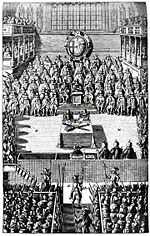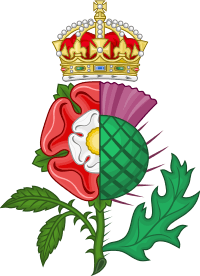British Empire/Consolidation at Home and Abroad
< British Empire|
British Empire
|

| | Completion status: this resource is ~10% complete. |
Introduction
This module covers the period 1603-1707. Student Feedback and discussion of content is encouraged on the discussion page accessed by the tab above.
Resources
The Union of the Crowns

With the death of Elizabeth I, James VI became the new Monarch of England, thereby uniting England and Scotland through the Union of the Crowns. James's accession to the throne was facilitated by the a series of secret correspondence conducted between James and courtiers in London. James' ambassadors, Earl of Mar and Edward Bruce, Commendator of Kinloss, first hoped to deal with Earl of Essex. However, as he was executed before their arrival, they were issued with new instructions[1] They gained the confidence of Robert Cecil and an understanding on the succession was reached, but their success was kept secret.[2] Following James' accession he became King James I of England. Never the less there were a number of plots which sought to overthrow him, the most notable being the Gunpowder Plot. James' attempts to have himself recognised as King of Great Britain were resisted both sides of the border.
The Scientific Revolution
The Royal Society was founded in November 1660 following a lecture by Christopher Wren at Gresham College. There was a mixture of both Royalists and Parliamentarians present when it was set up.
Key Individuals
Isaac Newton
Isaac Newton (1642 – 1727) Oliver Cromwell
See also
References
- ↑ Dalrymple, David, Lord Hailes, Secret Correspondence, (1766), pp.1-12, James to Mar, 8 April 1601.
- ↑ Houlbrooke, Ralph Anthony, James VI and I: ideas, authority, and government, Ashgate (2006), p.40.